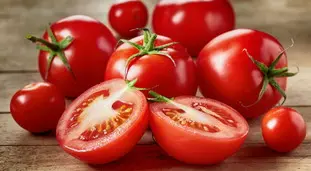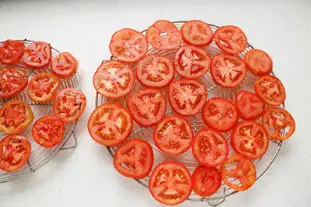The taste of raw tomatoes

Let's take a look at tomatoes, which are still in full bloom at the end of summer (as I write these lines), and which make for delicious salads.
I had already talked to you about the interest of peeling tomatoes, which gives them an extraordinary sweetness in the mouth, but let's talk about the taste this time. Of course, we are talking about seasonal tomatoes, which have grown in the area, and are both tasty and juicy.
I had already talked to you about the interest of peeling tomatoes, which gives them an extraordinary sweetness in the mouth, but let's talk about the taste this time. Of course, we are talking about seasonal tomatoes, which have grown in the area, and are both tasty and juicy.
16 K 4.9/5 (14 reviews)
Keywords for this post:TomatoesTasteSummerSeasonSaltJuiceExtractionLast modified on: September 8th 2018
The taste of raw tomatoes
Let's say you were going to make a salad with tomato slices, you might have peeled them (if not, try it as soon as possible!) and sliced them before putting them in your salad bowl. It's natural to do this, but it will have an unpleasant effect: when in contact with the dressing and the salt it contains, the tomato slices will give off a lot of juice, vegetation water in fact, and this juice will dilute the sauce in question. This means that if you prepare your tomato salad in advance, it is likely to be bathed in a very liquid juice-sauce mixture, which is not very pleasant.
Can this be avoided? Yes, there is a way to correct this problem, as in this recipe for example:
- You peel your tomatoes (if possible)
- You cut them into slices
- You lightly salt the tomato slices on each side with fine salt (very important)
- You put these salted slices on a grid, and you let them rest for 1 hour if possible, 30 minutes minimum
Doing it this way will have 2 effects:
1) The fine salt in contact with the tomato slices, will pump some of the water that will fall under the grill, which will "dry" the tomatoes a little, and all this water will not go into your salad afterwards.
2) The salt will enhance the taste of your tomatoes
After the resting time, drain carefully the slices, continue your tomato salad as you were used to, but think about reducing or removing the salt from your sauce, since you bring it with the tomatoes, and we must always be careful with salt in our diet.
This way of proceeding can also be applied for stuffed tomatoes for example: once hollowed out, salt the inside and put them upside down on a grid for 1 hour. Then use as usual.
To sum up: Before using tomatoes in a recipe, especially raw, it is always better to salt them with fine salt, and let them rest for a good hour so that the excess vegetation water escapes, and then use them normally.
What to do with the tomato water recovered in this way? Put it in a closed jar in the fridge, and pour it into a sauce or the cooking of your next recipe based on cooked tomatoes. Or... make yourself an amazing, clear Bloody-Mary!
Can this be avoided? Yes, there is a way to correct this problem, as in this recipe for example:
- You peel your tomatoes (if possible)
- You cut them into slices
- You lightly salt the tomato slices on each side with fine salt (very important)
- You put these salted slices on a grid, and you let them rest for 1 hour if possible, 30 minutes minimum

Doing it this way will have 2 effects:
1) The fine salt in contact with the tomato slices, will pump some of the water that will fall under the grill, which will "dry" the tomatoes a little, and all this water will not go into your salad afterwards.
2) The salt will enhance the taste of your tomatoes
After the resting time, drain carefully the slices, continue your tomato salad as you were used to, but think about reducing or removing the salt from your sauce, since you bring it with the tomatoes, and we must always be careful with salt in our diet.
This way of proceeding can also be applied for stuffed tomatoes for example: once hollowed out, salt the inside and put them upside down on a grid for 1 hour. Then use as usual.
To sum up: Before using tomatoes in a recipe, especially raw, it is always better to salt them with fine salt, and let them rest for a good hour so that the excess vegetation water escapes, and then use them normally.
What to do with the tomato water recovered in this way? Put it in a closed jar in the fridge, and pour it into a sauce or the cooking of your next recipe based on cooked tomatoes. Or... make yourself an amazing, clear Bloody-Mary!
Lasts posts
Butter vs. grease
We often read in a recipe where a pastry is put into a mould that, just before pouring, the mould should be buttered or greased. But what's the difference between these 2 terms?December 1st 20255765
Getting out of the fridge early
Very often when you're cooking, you need to take food or preparations out of the fridge, to use them in the recipe in progress. There's nothing tricky about this: you just take them out of the fridge and use them, usually immediately, in the recipe. But is this really a good method?November 24th 20259285
Who's making the croissants?
When you look at a bakery from the outside, you naturally think that in the bakery, the bakers make the bread, and in the laboratory, the pastry chefs make the cakes. It's very often like that, with each of these professions having quite different ways of working, but sometimes there's also one...November 23th 2025830
Oven height
When we put a dish or cake in the oven, we naturally tend to put it on the middle shelf, and that's what we usually do. But in some cases, this position and height can be a little tricky, so let's find out why.October 8th 20252,4185
The importance of sieving
In recipes that use a fine powder (flour, powdered sugar, etc.), you'll often see the advice to sift before using it. To sift is to pass the powder in question through a sieve (a very fine strainer) before incorporating it into your recipe. It's often advice, but is it really useful?September 3rd 20257,3153
Other pages you may also like
Unmoulding cakes while hot
When you make a cake, pound cake or whatever (what bakers call a "travel cake" because it's easy to carry around) you've most likely made a batter, either by hand or in a food processor, which you then pour into a buttered pan. It's a classic, and I've already talked to you about 2 or 3 tips on...February 6th 202138 K4.6
Should I believe my oven?
Can you really trust your oven? This is an important question as we are always tempted to take the temperature indicated as gospel truth and, unfortunately, this is rarely very precise. .July 4th 201132 K4.6
Butter doesn't make you fat, unless you eat too much of it.
Whenever I'm discussing cooking and recipes, there is one idea which comes up frequently, like this: "Oh no! But that's got butter in it" (I should add, for the sake of accuracy, that this is something I hear more frequently from women, who are almost all concerned with keeping their figure). ...March 26th 201245 K4.5
Making the most of seeds: Dry roasting
In cooking, and particularly in baking, there are a lot of seeds we can use, such as linseed, sesame, poppy, etc. Usually, recipes simply say to add them just as they are to the mixture or dough. To make a seeded loaf, for example, prepare a plain bread dough as usual, then, towards the end of...January 30th 201562 K4.0
Perpetual stock
It's something you have probably have done yourself: cooked or pre-cooked vegetables before adding them to a recipe. This is almost always done the same way: peel the chosen vegetables (carrots, for example), cut them up, boil them in salted water (using a tablespoon or so of coarse salt per litre),...November 22th 201631 K5
Post a comment or question
Follow this page (as 2 people already do)
If you are interested in this page, you can "follow" it, by entering your email address here. You will then receive a notification immediately each time the page is modified or a new comment is added. Please note that you will need to confirm this following.
Note: We'll never share your e-mail address with anyone else.
Alternatively: you can subscribe to the mailing list of cooling-ez.com , you will receive a e-mail for each new recipe published on the site.









